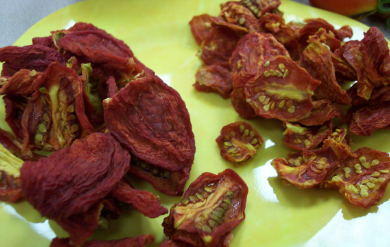Drying Tomatoes
Tomatoes can be dried for home use. A dehydrator will give the best results in Oklahoma. Fruits can be safely dried in the sun because they are high in sugar and acid. The lower levels in tomatoes, especially tomatoes picked during very hot weather or from diseased or dying vines, increases the risks for food spoilage.
Dried tomatoes do not hydrate well for use in salads. Plan to use them as dried tomatoes or in cooked products such as soups, sauces, and stews.
Roma or paste tomatoes are best for drying due to their high solids content. This means they have less water to evaporate and you are left with more tomato when the process is complete.
 Choose firm, ripe, tomatoes. They should be heavy for their size, thick-walled, with a high
acid content. Store tomatoes waiting to be dried at room temperature, not in the refrigerator.
Choose firm, ripe, tomatoes. They should be heavy for their size, thick-walled, with a high
acid content. Store tomatoes waiting to be dried at room temperature, not in the refrigerator.
Prepare the tomatoes by washing them in cool, drinkable water. You may peel or not as desired. To loosen the peel, steam or dip in boiling water for 30 to 45 seconds. Chill in ice water then peel. Remove the center stem and core. Slice plum tomatoes lengthwise in 1/2- to 3/4-inch slices or halve or quarter.
Dry in a dehydrator set at 140oF. Set tomatoes on drying trays with the skin side down. Tomatoes are dry when they feel tough to crisp. Cool the tomato to room temperature to check for doneness. Drying will take 10 to 18 hours.
Store dried tomatoes in clean moisture-vapor-resistant containers. Glass jars, metal cans or freezer containers are good choices if they have tight-fitting lids. Plastic freezer bags are acceptable, but they are not insect and rodent proof. Put containers of dried tomatoes in a cool, dry, dark place. Cooler storage temperatures will greatly extend the shelf life of dried tomatoes. To store for extended periods place the sealed containers in the freezer.
Sources:
- Harrison, J. A. and Andress, E. L. “Preserving Food: Drying Fruits and Vegetables,” U. of Georgia Cooperative Extension Service, http://www.uga.edu/nchfp/publications/uga/uga_dry_fruit.pdf
- DeLong, Deanna. (1992) How To Dry Foods, HP Books, The Berkley Publishing Group, 200 Madison Ave., New York, NY 10016
Barbara Brown, Food Specialist
Oklahoma Cooperative Extension Service
